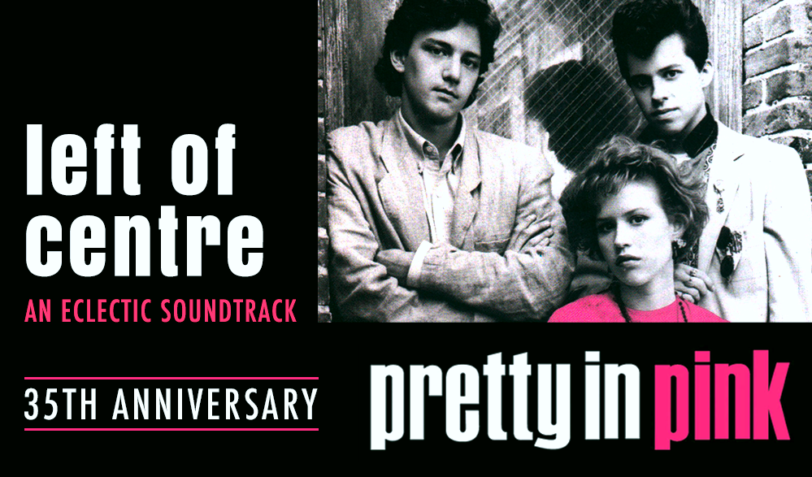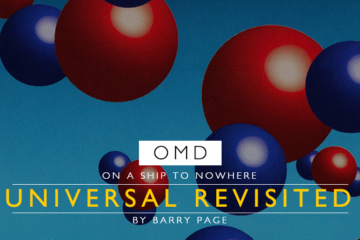The deeper you get, the sweeter the pain…
In the slow evolution of teen movies through the 1970s and 1980s, the choice of music usually stuck to either a traditional use of reliable classics or relied on contemporary rock music to carry the day. It was very rare for the soundtrack to take on an equal importance or weight to the main narrative.
But John Hughes’ 1986 movie Pretty In Pink (read the Wavegirl essay on the film’s legacy) was a very different film – and its use of music reflected this. The (then) contemporary movie showcased mid-1980s culture through a much broader selection of music. In doing so, it also demonstrated how eclectic music of the period actually was. In the modern era, it’s easy to categorise music as slotting into convenient pigeon holes of rock, pop, electronic etc. but the 1980s was actually surprisingly more diverse – and Pretty In Pink’s soundtrack captured that idea perfectly.
It was certainly unusual for movies that could tread the line between cool and commercial when it came to music. Yet Pretty In Pink combined brash rock outings, such as The Psychedelic Furs’ titular ‘Pretty In Pink’, alongside the likes of synth-pop outfits such as New Order and OMD’s lush ‘If You Leave’. But it also threw in some of the cooler alternative rock acts such as The Smiths and Echo & The Bunnymen to give the soundtrack a quirky, leftfield vibe.
The sleeve notes for the soundtrack album, penned by John Hughes himself, summed it up:
The music in Pretty In Pink was not an afterthought.
The tracks on this album and in this film are there because Howie Deutch and I believe in the artists, respect the artists and are proud to be in league with them.
That ear for music served John Hughes well for the other films that the filmmaker wrote and/or directed. From his initial 1984 offering Sixteen Candles, through the iconic The Breakfast Club and the later Ferris Bueller’s Day Off and beyond, music clearly played an important role in his films. But it was Pretty In Pink that somehow captured something particularly special.
The Breakfast Club also served as a perfect vehicle to launch Simple Minds onto the American music scene. Although ironically, ‘Don’t You (Forget About Me)’, which acted as the film’s theme song, wasn’t actually composed by the band. In fact, it had been written by Keith Forsey and had originally been pitched in turn to both Billy Idol and Bryan Ferry. The song was also turned down by Chrissie Hynde of The Pretenders, who then suggested they offer it to the band fronted by her husband at the time, Simple Minds.
Pretty In Pink’s music also features a predominantly UK presence, something which runs counter to a tradition of US-based music that the film’s contemporaries employed. As a result, Pretty In Pink managed to give a lot of these acts a boost for their US careers (similar to Simple Minds) – particularly OMD, who had struggled for years to get a foothold in America.
New Order perhaps had more cultural cache than OMD at the time, having already made in-roads into the New York club scene care of their 1983 outing ‘Confusion’ and their work with Arthur Baker. But it was also unlikely that New Order could have served up a song that slotted so neatly into the film’s closing moments as OMD’s offering.
New Order’s club-orientated sound had a transformative effect on their music, of which ‘Shellshock’ is probably a good example. The song, later released as a single, shares production credits with John Robie and draws inspiration from the 1983 R&B outing ‘One More Shot’, which Robie had also been responsible for.
The instrumental version of New Order’s earlier 1984 song ‘Thieves Like Us’ (which also features in the film) also appeared as the B-side to the 7-inch release of ‘Shellshock’. Meanwhile, the 12-inch release boasted an extended mix of nearly 10 minutes.
The downbeat ‘Elegia’ (a track that was originally written in memory of Ian Curtis), which also features in the film, had also appeared on New Order’s classic 1985 album Low-Life. The instrumental number was actually edited down from an original 17-and-a-half minute recording that the band had produced (later released on their 2002 compilation release Retro and the 2008 reissue of Low-Life).
‘Shellshock’ was incredibly successful for New Order, providing the Manchester outfit with their first gold discs. It also proved to be an international hit, making the mainstream chart not only in the UK, but also Australia and New Zealand.
OMD’s contribution to Pretty In Pink had a more difficult gestation. John Hughes had already been an OMD fan before he met the band and was very keen for them to pen a song for his new film. Originally, OMD had served up ‘Goddess Of Love’ which utilised samples, brassy refrains and synthesised steel drum, all of which delivering a suitably brash pop vibe.
Lyrically, the song was conceived as very much a narrative based on Molly Ringwald’s character and had been written for the film’s denouement. However, test audiences had balked at Pretty In Pink’s original ending in which Molly Ringwald’s character Andie walks off into the sunset with Jon Cryer’s Duckie. As a result, the film was re-edited to suit a new storyline. On that basis, ‘Goddess Of Love’ suddenly didn’t fit the new ending, which put Paul Humphreys and Andy McCluskey into a crisis over what to do.
They opted to write and record a new song for the film and found themselves in a small private cinema in LA to watch a rough cut of the new edit of the film. It’s interesting to note that at this stage, the film’s prom scene finale had the cast dancing to ‘Don’t You (Forget About Me)’ (which had previously been used for John Hughes’ earlier film The Breakfast Club), which gave OMD a template of sorts to adapt to on the basis that the song had to be 120bpm.
Andy and Paul then whisked themselves off to Larabee Studios in Los Angeles with engineer Tom Lord Alge and the rest of the band. Lord Alge had previously worked with OMD on the 12” mix of their earlier single ‘La Femme Accident’, so they were already on familiar terms.
The band only had three days to produce the song as they were due to resume touring. That produced a challenge as they were still in the process of writing the new song! “We began at 5pm” recalled Paul Humphreys in the 1987 OMD biography Messages, “and just thrashed ideas around all night. It must have ben 4am before we got something that sounded promising.”
The rough song, now titled ‘If You Leave’, was played to John Hughes and Howard Deutch, who both loved the song, leading the band returning to the studio with Lord Age to record the finished track (read more about the creation of ‘If You Leave’ via the feature on Messages).
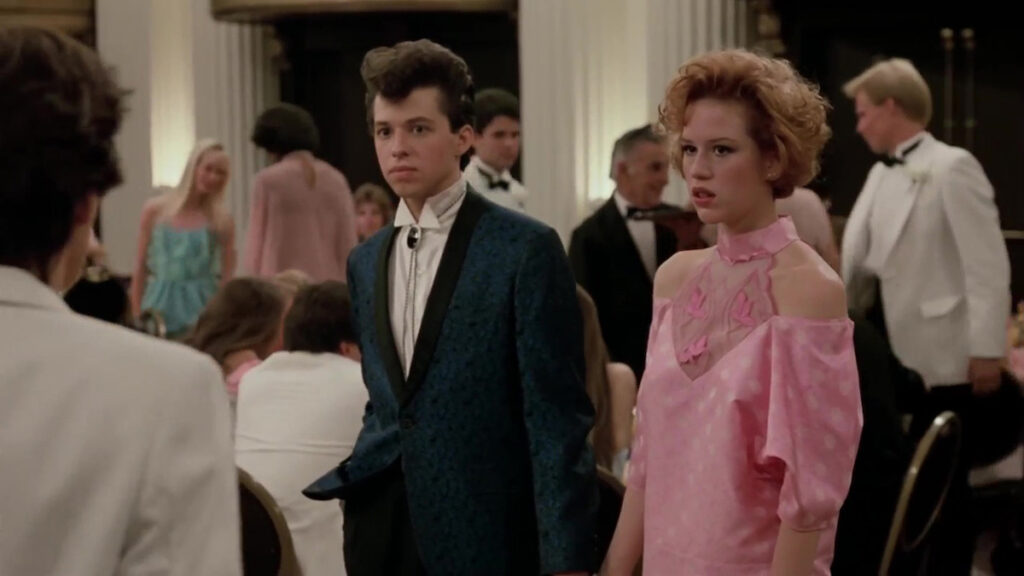
Meanwhile, OMD contemporaries Echo & the Bunnymen also benefited from being included in the film’s soundtrack via ‘Bring On the Dancing Horses’. The song’s wistful guitar melodies and psychedelic washes gave the song a curiously lovelorn aspect, a vibe that seemed in keeping with Pretty In Pink’s themes (even if the track itself is relegated to a brief radio appearance in the film itself).
The Bunnymen song had emerged from a Brussels session with producer Laurie Latham, but proved to be the only song of a batch that the band managed to whip into shape during production. Originally titled ‘Jimmy Brown’, initial responses to the song by others on the Bunnymen team were mixed, but their record label WEA loved the lush sweep of the song. With a new album still on the far horizon, WEA convinced the band to issue a greatest hits compilation (titled Songs To Learn And Sing) of which ‘Bring On the Dancing Horses’ would lead the way as a new single.
The inclusion of the track on the Pretty In Pink soundtrack boosted the Bunnymen’s US profile (despite the song being relegated to essentially a background presence for one scene). By the summer, the Pretty In Pink soundtrack had sold one-and-a-half million copies in the US alone.
During the mid-1980s, The Smiths had already seen their star ascending based on their ability to combine Morrissey’s intellectual flair for lyrics against Johnny Marr’s clear talent for melody and arrangement. ‘Please, Please, Please, Let Me Get What I Want’ is a simpler outing from the Manchester band, originally released as a B-side to their 1984 single ‘William, It Was Really Nothing’.
Again, the song’s angsty and forlorn themes seemed to be the perfect match for Pretty In Pink’s tale of romantic drama. The song clearly made an impression on John Hughes because he revisited it for his 1986 film Ferris Bueller’s Day Off (albeit in the form of a cover version by The Dream Academy).
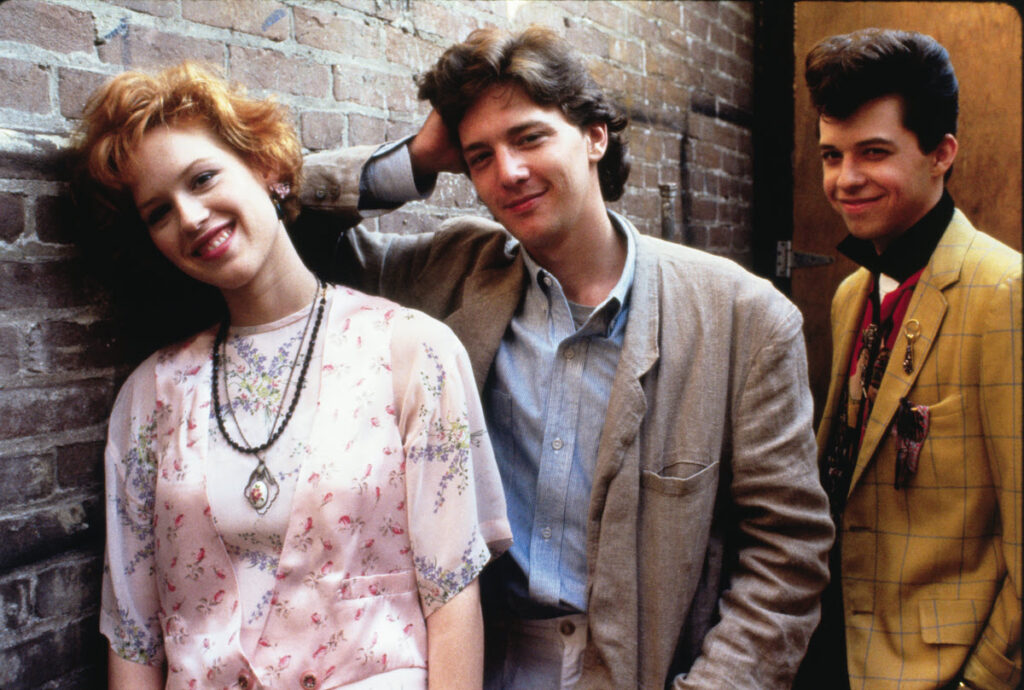
Meanwhile, Belouis Some’s ‘Round, Round’ offered up a slice of alternative pop that seemed to be custom-built for Pretty In Pink’s off-kilter soundscape. Belouis Some was conveniently placed for this break having moved from his native UK to record in New York from 1984. Working with the likes of Carlos Alomar and Earl Slick, he later released the Some People album in 1985, along with the (controversial) video for ‘Imagination’. ‘Round Round’ had emerged during a recording session with producer Bernard Edwards, recorded in LA in August of 1985.
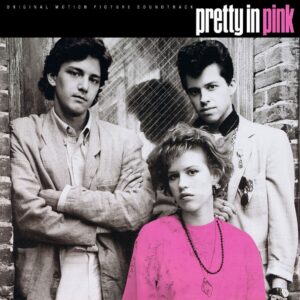
The film’s titular song has a more intriguing back story. Originally penned by The Psychedelic Furs for their 1981 album Talk Talk Talk, the composition was more raw in its original incarnation and lacked the sax elements that the film version used.
John Hughes had initially taken inspiration from the Psychedelic Furs’ 1981 song ‘Pretty In Pink’. Molly Ringwald had been a big fan of the band and brought the song to his attention. However, the themes of the song are a lot darker and sleazier, so it’s no surprise that the filmmaker took the film’s plot off in a different direction.
“It’s about a girl who sleeps around a lot and feels like she benefits from it” commented the Furs’ Richard Butler on the song, “whereas in reality people are talking and laughing about her behind her back. “All of her lovers all talk of her notes and the flowers that they never sent” – they have no respect for her. The line “she loves to be one of the girls” suggests she’s living the way she thinks society tells her to, but it doesn’t make her happy. I like to think she ended up happily married. The sarcasm, sorrow and general malaise and melancholy are autobiographical”.
You can’t fault the song’s power in the film, which has all the brash pop rock allure designed to draw the audience’s attention in. Arguably, the original has a much more earthy, gritty appeal to it but the re-recorded version shifts the song into a much bigger, suitably widescreen setting.
As a singer-songwriter, Suzanne Vega’s fortunes seemed to line up very neatly with the advent of Pretty In Pink. Her folk-tinged compositions formed a sturdy foundation for her success, particularly via her eponymous 1985 debut. Songs such as ‘Marlene on the Wall’ had a simple, emotional weight to them. But Vega would later score more success through the slice of life outing of ‘Tom’s Diner’.
‘Left of Center’, penned by Suzanne Vega and Steve Addabbo also features Joe Jackson on piano. The song is almost a theme song for the disaffected and misfits and even though it’s stylistically miles away from the other songs on the soundtrack, ‘Left of Center’ still radiates a particular power.
Prior to embarking on a solo career, Jesse Johnson was guitarist for Prince’s music project The Time. Johnson was a talented multi-instrumentalist who went on to sign with A&M Records in 1984. ‘Get To Know Ya’ certainly offers up an outing that wears its Prince influences on its sleeve, but also serves as a demonstration in how broad Pretty In Pink’s soundtrack was.
BUY NOW
AMAZON
Australian pop rock combo INXS also feature with the spirited ‘Do Wot You Do’, although by this point the band had already achieved global success so appearing on a soundtrack was almost an afterthought at this point.
Nik Kershaw’s 1984 hit ‘Wouldn’t It Be Good’ make its mark on the UK charts at the time of its release. Here, the version via American outfit Danny Hutton Hitters (fronted by Three Dog Night’s Danny Hutton) doesn’t do anything too radical with the song, but does give it a slightly more edgy vocal take.
There’s a few other acts whose music rocks up in Pretty In Pink, but who don’t feature on the album. This includes The Rave-Ups, an American rock outfit whose singer was dating Molly Ringwald’s sister at the time (in Sixteen Candles, Molly Ringwald’s character also has their name scrawled on a school book). They’re also the only band to feature in the film, performing at the club where Andie and Duckie hang out. ‘Positively Lost Me’, one of the songs The Rave-Ups perform, was considered a cult hit in light of the film’s success.
The arrangement of the songs on the Pretty In Pink album is also quite unusual, with OMD’s big finale opening the album and The Psychedelic Furs bombastic number appearing in the middle of the album. In many ways, this adds to the quirky nature of the music choices but doesn’t dilute it as a classic compilation.
As a film, Pretty In Pink will always be considered a classic that still manages to hold its charm today. The music, in all its odd and eclectic glory, will also serve as a window on a particular period of time. It’s no surprise that Pretty In Pink’s soundtrack album featured in Rolling Stone magazine’s The 25 Greatest Soundtracks of All Time listings and is still considered a great music compilation album some 35 years after its release.
To quote the film, it’s an incredibly romantic moment.
Pretty In Pink celebrates its 35th Anniversary today. Read more about the film:
Wavegirl: Pretty In Pink:35th Anniversary
Messages: The Story Of ‘If You Leave’


